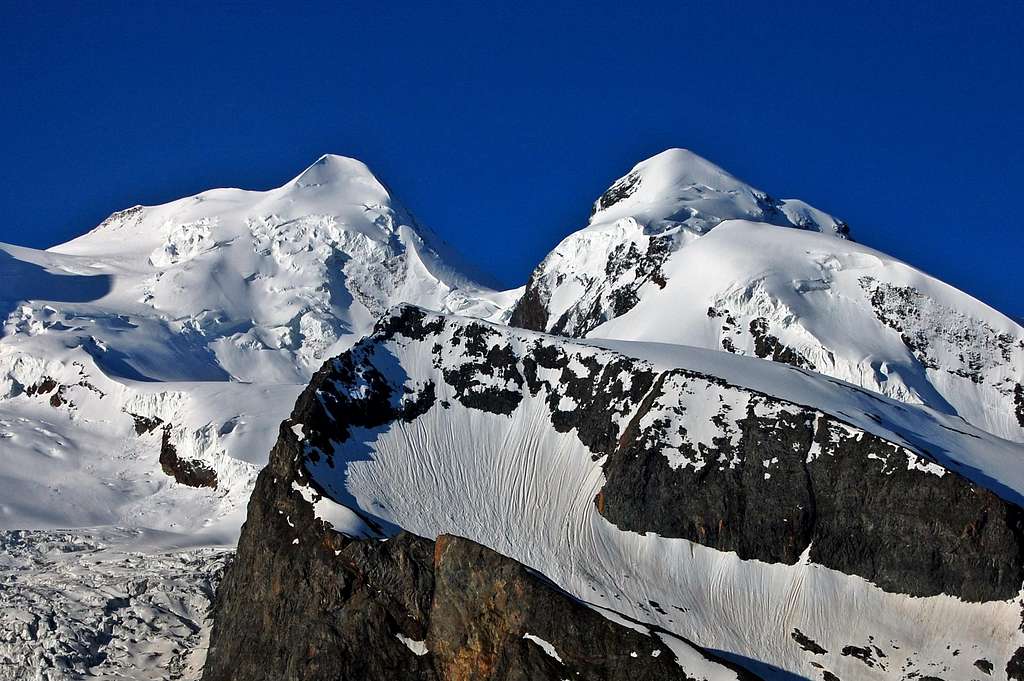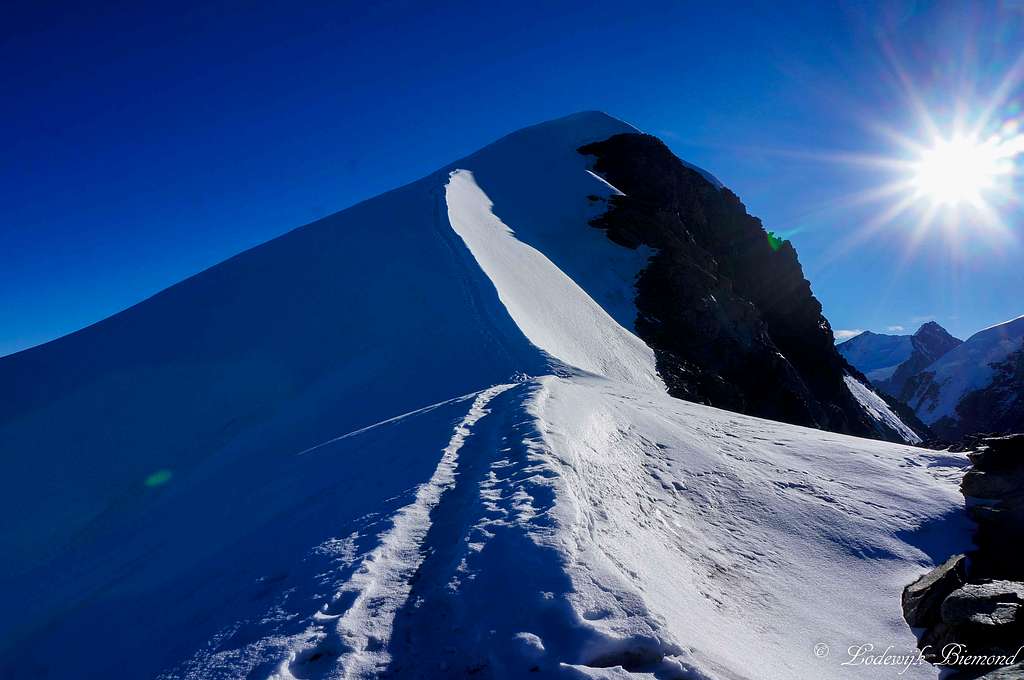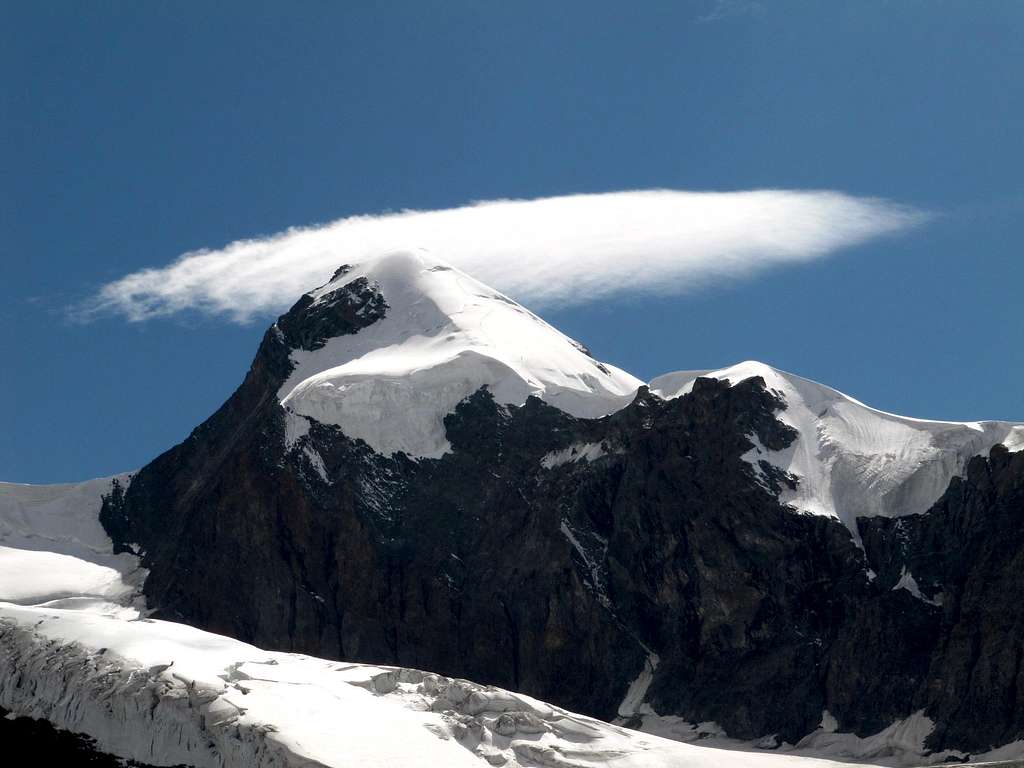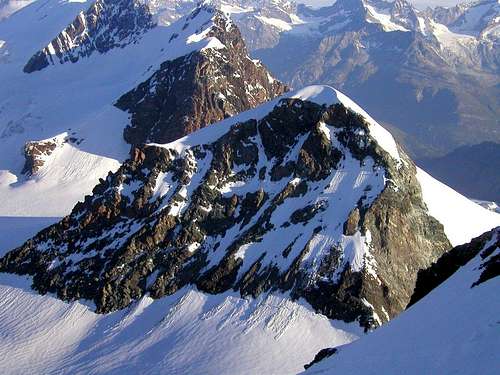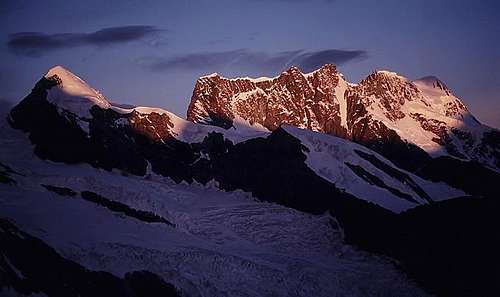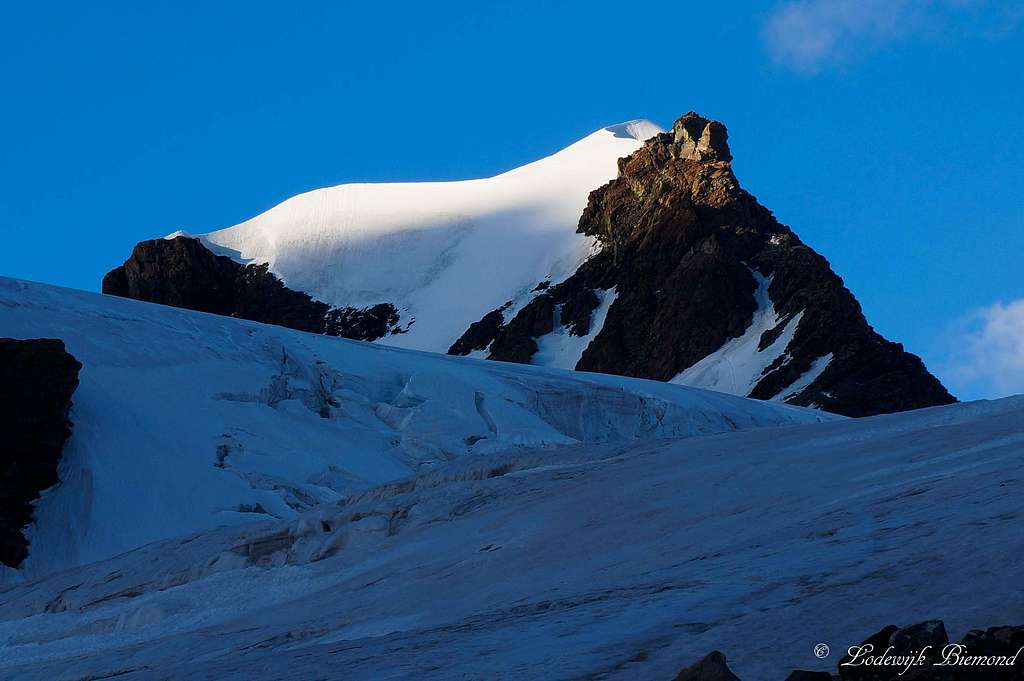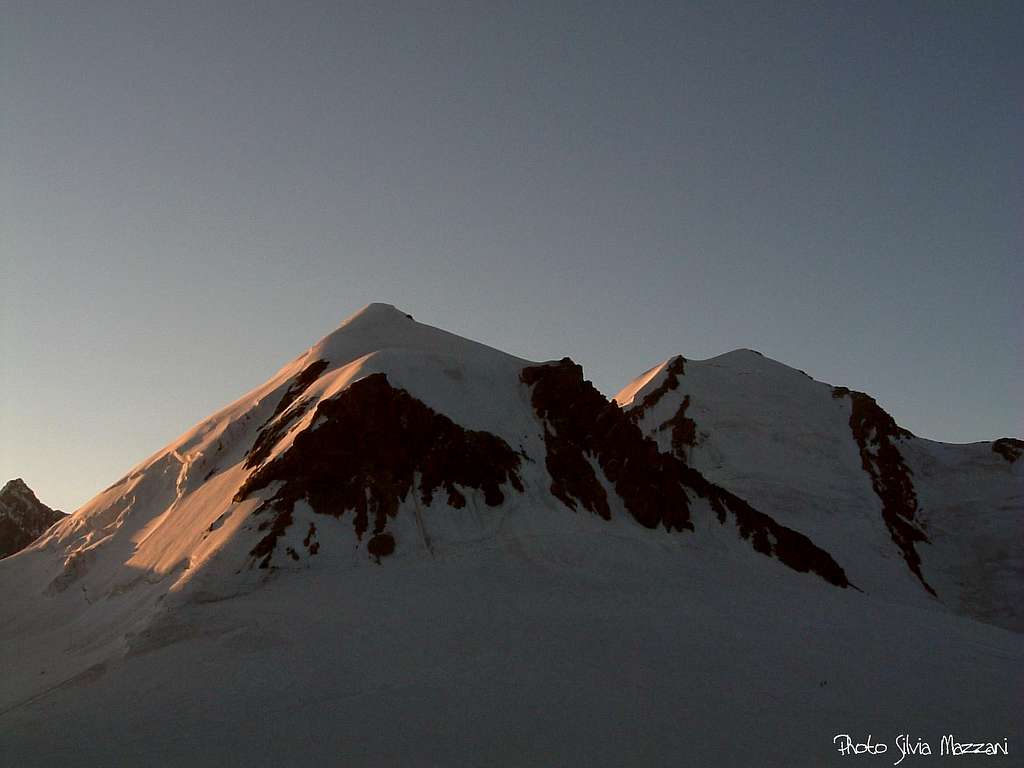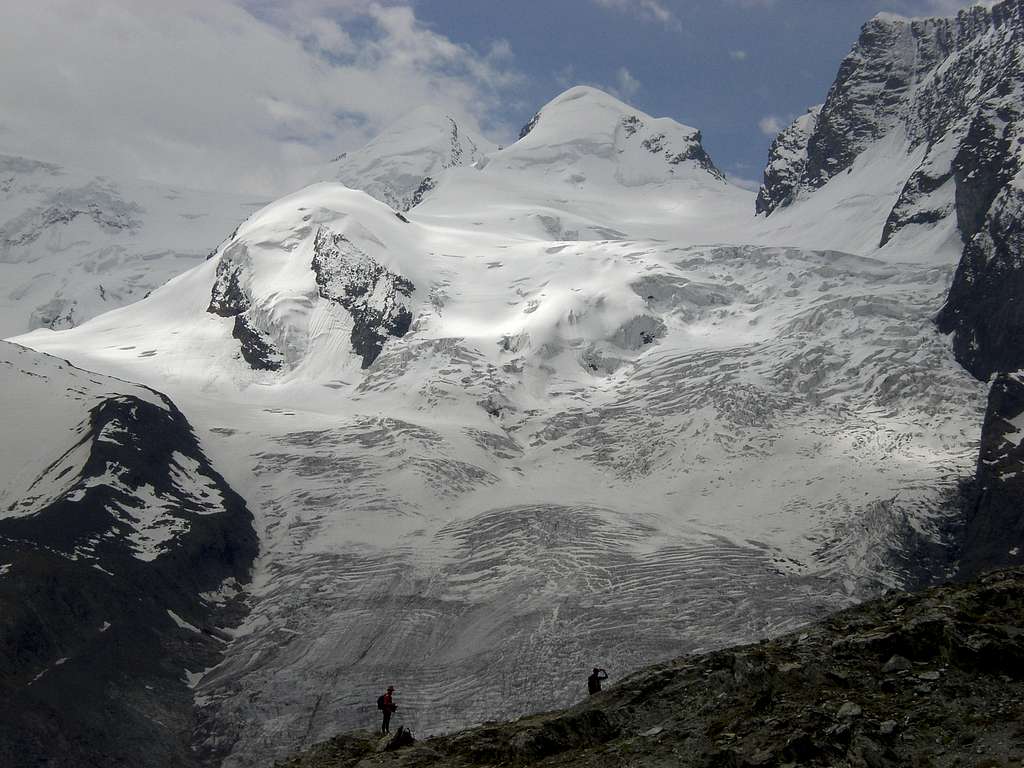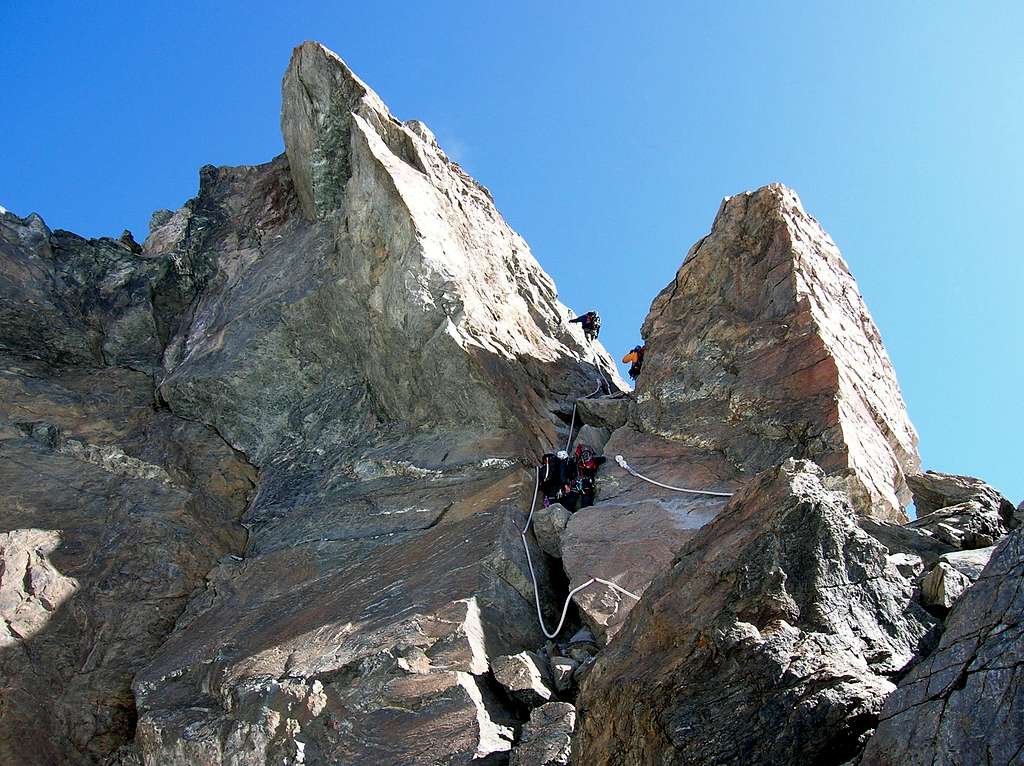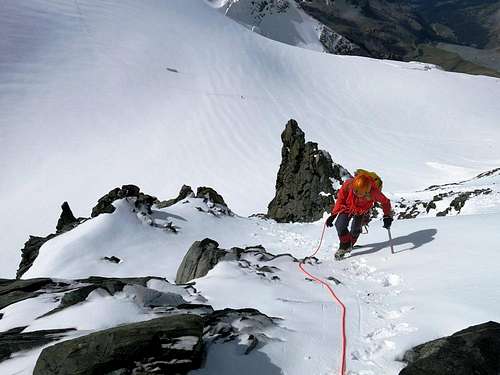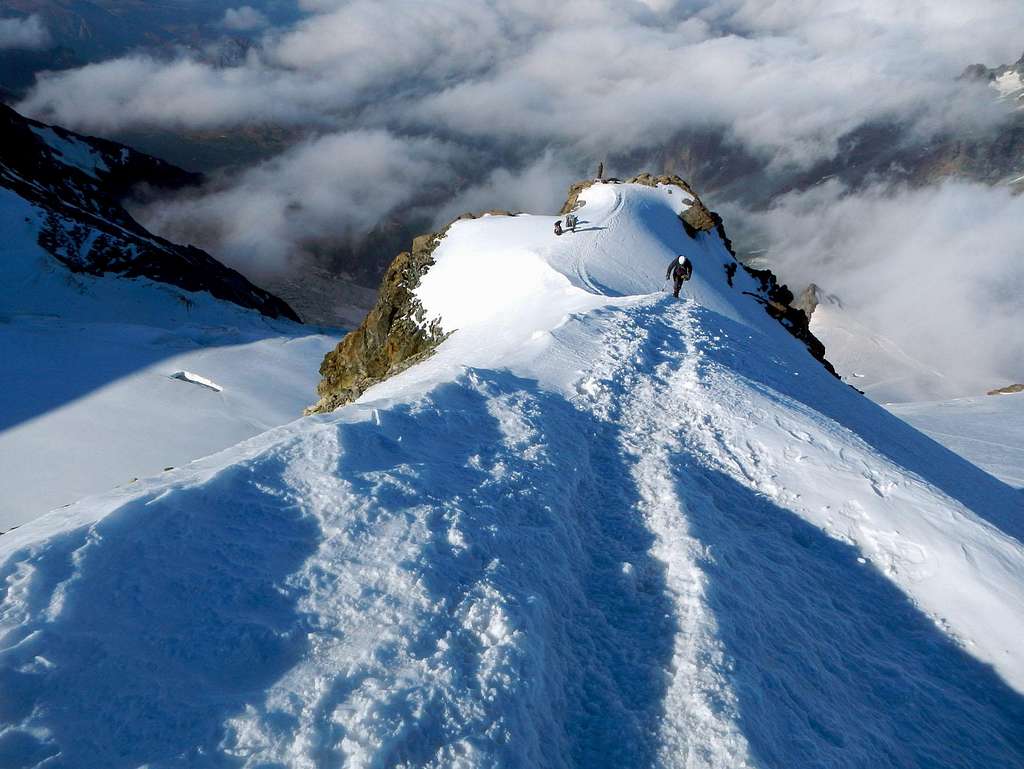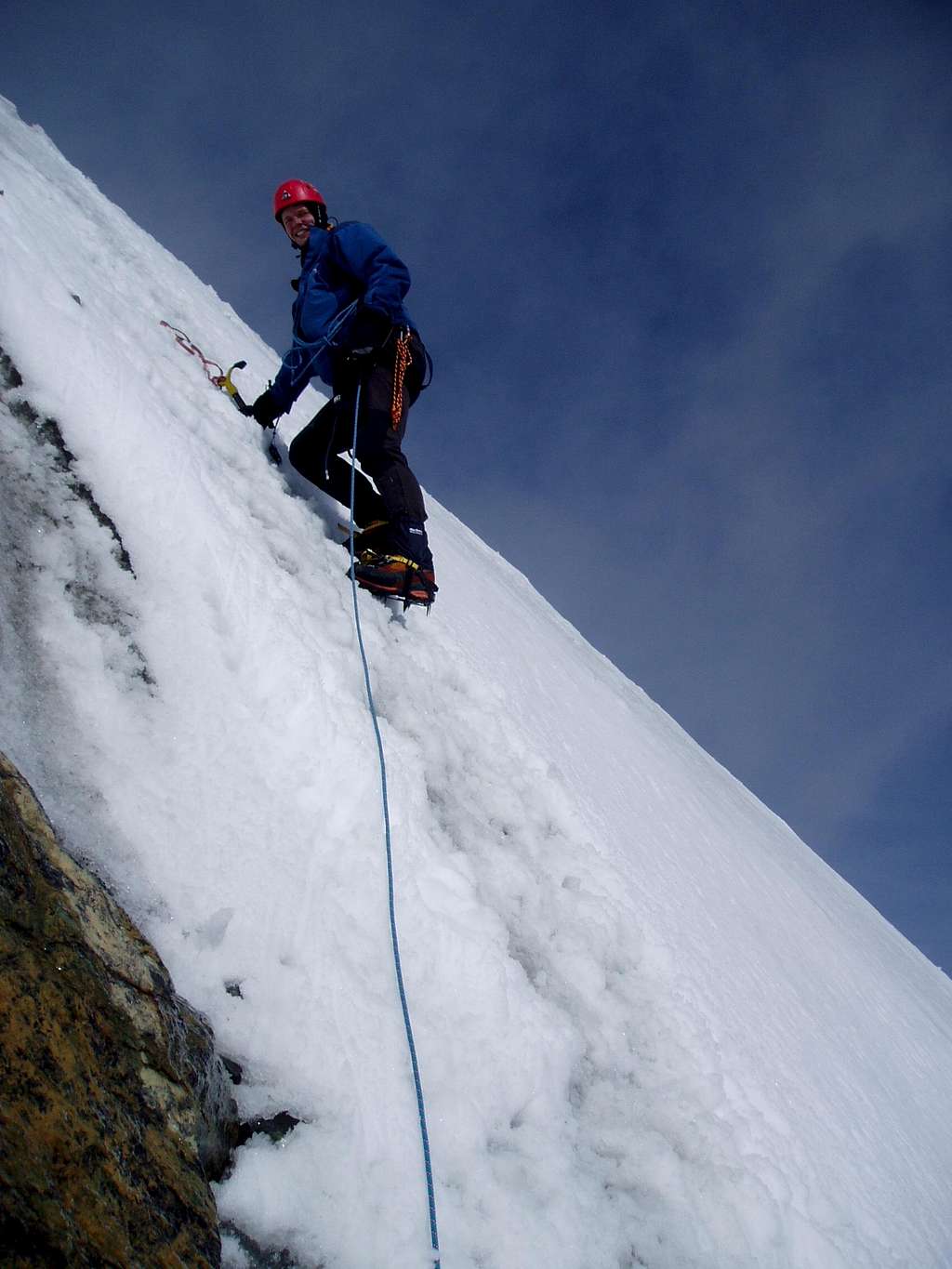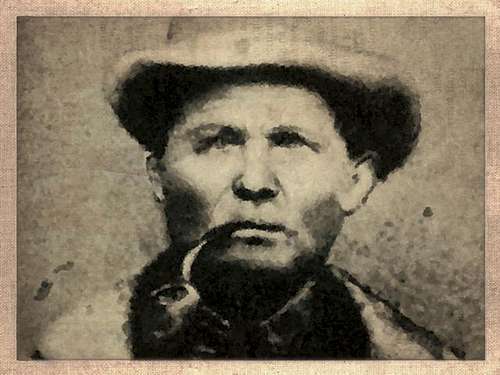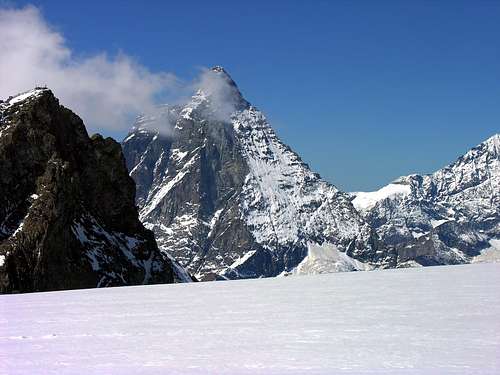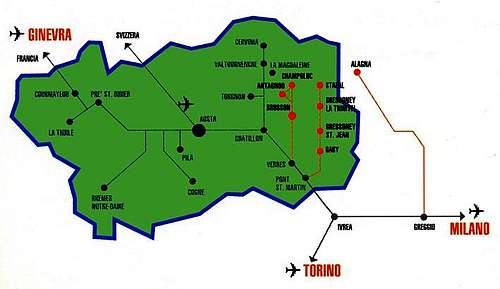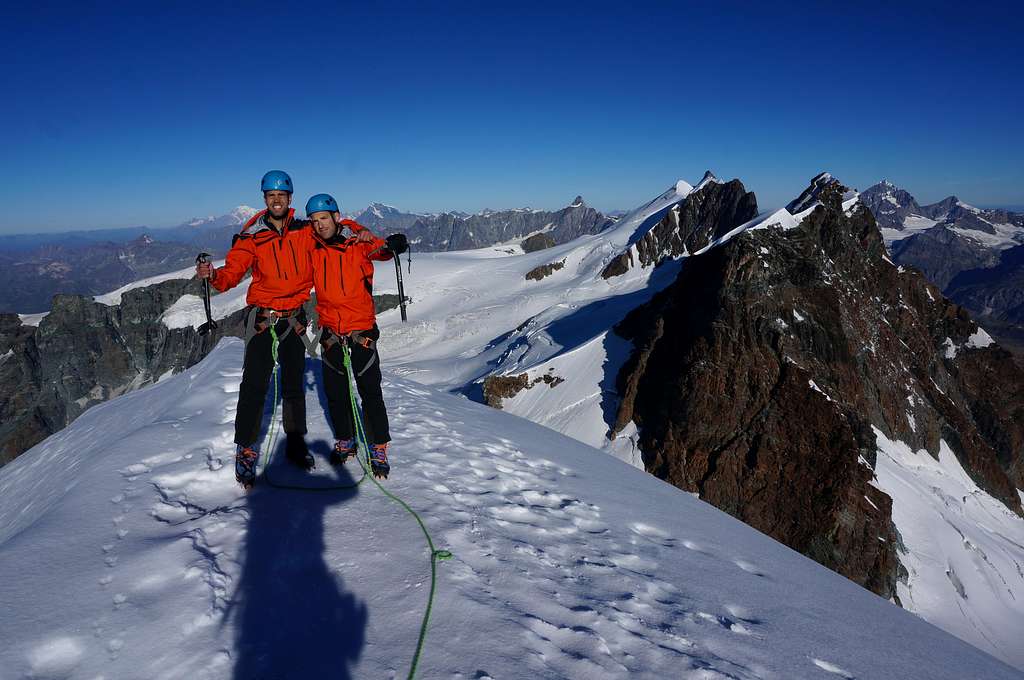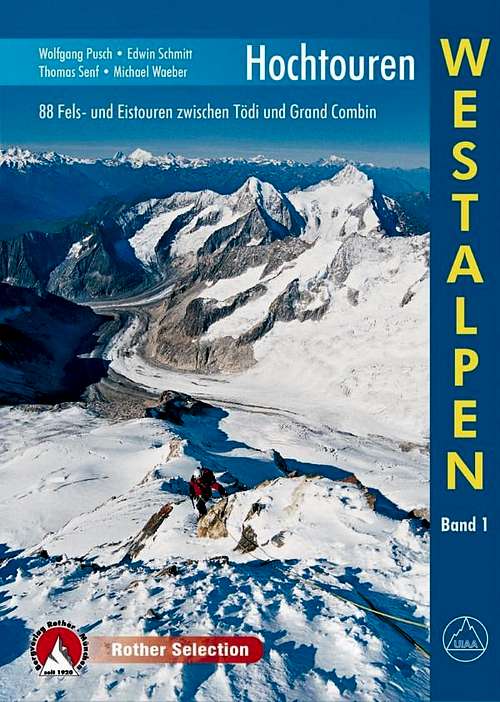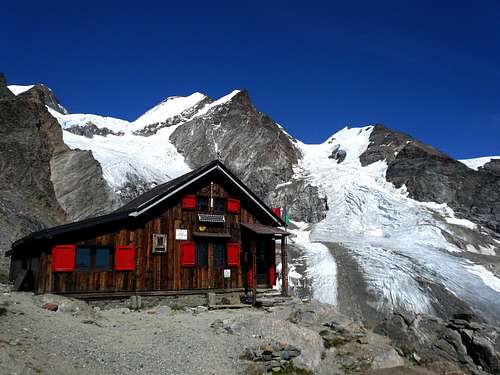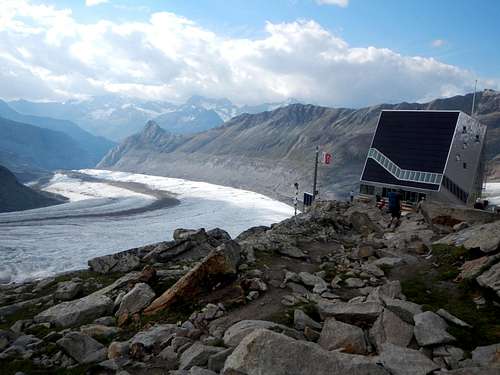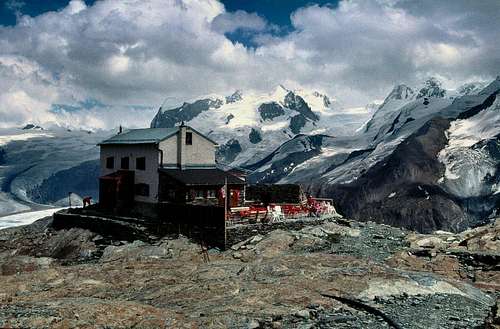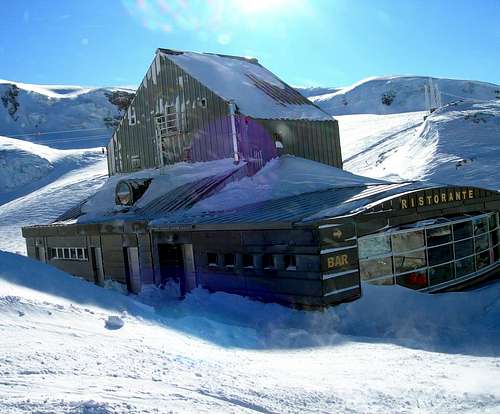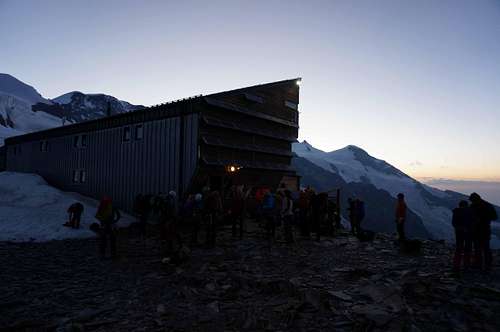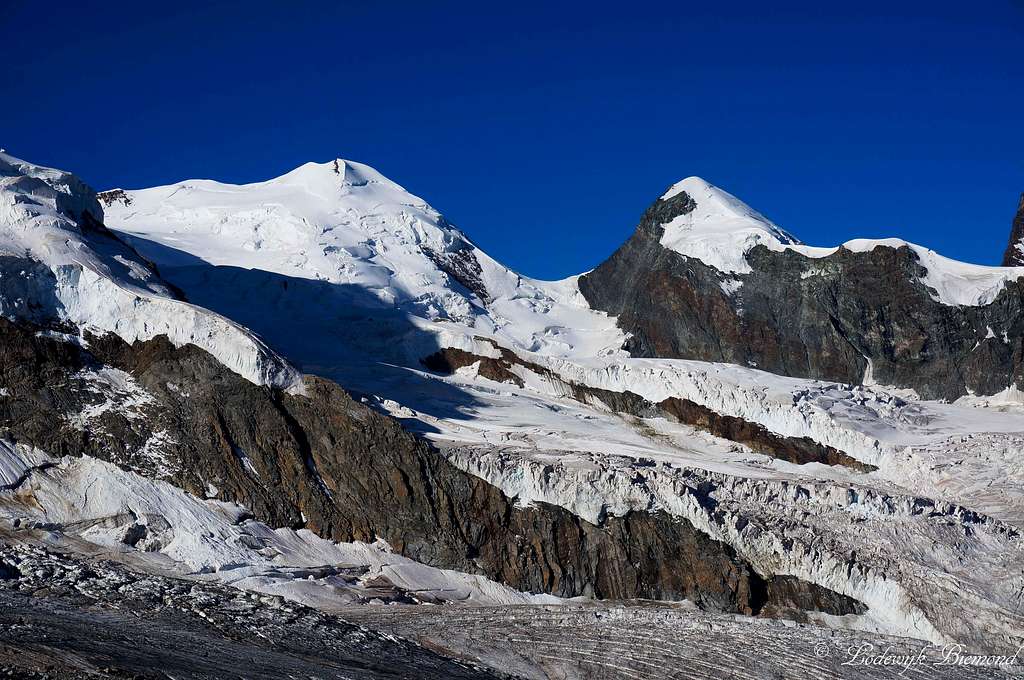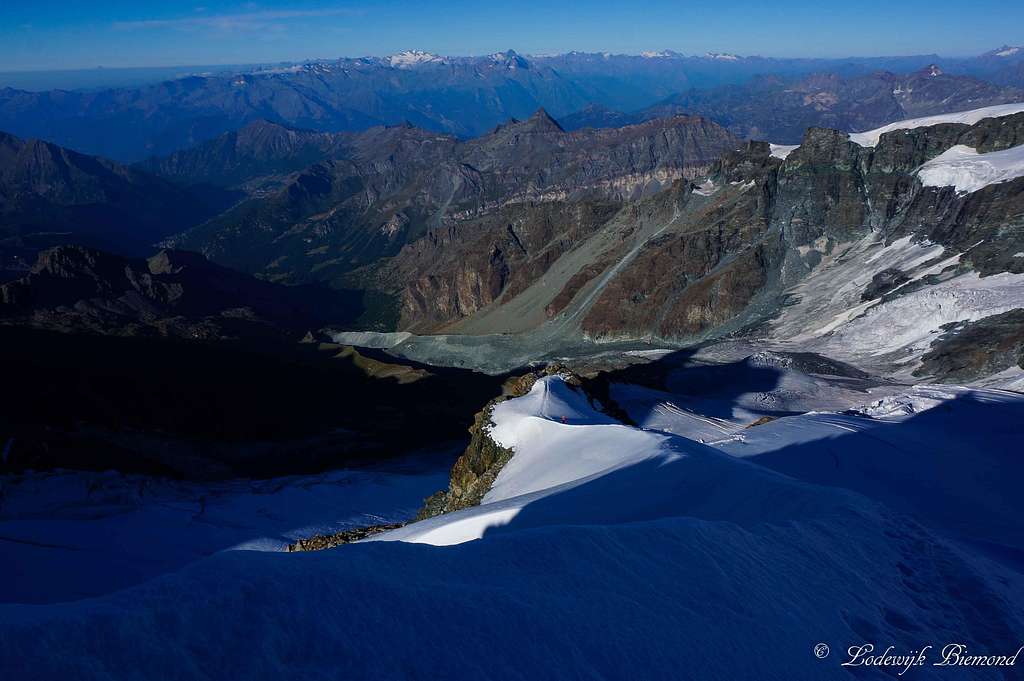|
|
Mountain/Rock |
|---|---|
|
|
45.92757°N / 7.78537°E |
|
|
Mountaineering |
|
|
Spring, Summer, Fall |
|
|
13425 ft / 4092 m |
|
|
Overview
Pollux is one of the 82 peaks above 4000 meters in the Alps (UIAA-list). Pollux is one of the twins , the other one is its slightly higher neighbor Castor and together they form the illustrious duo from the Greek mythology: Castor and Pollux. The reason is clear when you look at the peaks from the Zermatt (or Swiss) side of the mountain: Castor and Pollux appear near identical to one another. This is the clear reason both peaks are often referred to as the ‘’Zwillinge’’, which translates from German as ‘twins’. Pollux was first climbed by Jules Jacot from Geneva with guides Josef-Marie Perren and Peter Taugwalder on the first of August in 1864.
Polluxranks 55th in the list of highest peaks in the Alps and is often climbed, especially in summer when on a normal day, between 10 and 40 climbers reach Pollux’ summit. Although Pollux is the smaller brother of Castor when you look at elevation, Pollux is the harder one to climb. The easiest route is along the 45 degree West Flank and is a route purely on snow and/or ice. This route is graded PD. The route along the West face is often not in condition and there is increased danger of rockfall later on the day. As a result most climbers choose to ascent along the SW-ridge, which is regarded as the safer alternative and therefore the most ascended route. The SW-ridge (as well as the NE-ridge) involves rock climbing up to the third degree (UIAA III) and both routes are graded PD+.
The combination of rock climbing together with snow and ice make Pollux a popular objective. Often people regard to Pollux as one of the nicer normal routes (the SW-ridge in this case) on a 4000 meter mountain in the Monte Rosa Group and I for one second that. The popularity ofthe mountain has several reasons like for instance the accessibility: It ispossible to climb Pollux as a day trip by using the Klein Matterhorn cableway up from Zermatt. Also, the Ayas and Mezzolama Huts are nearby and the peaks are often climbed as a part of the so-called Spaghetti Tour, a round tour that includes climbing over 10 of the Monte Rosa 4000-meter peaks within a week. Of course the fact that Pollux is one of the 82 4000 meter peaks of the Alps attracts climbers as well.
Pollux is located on the border of Switzerland and Italy. The border crosses the peak from west to east and goes exactly over the summit. (Switzerland is north of the border and Italy south.) The mountain ridge Pollux is situated on stretches more or less from west to east and has several 4000 meter peaks on it. From west to east the main summits are Breithorn (5 summits), Pollux, Castor and Lyskamm West & East. The border follows this ridge as well. To the north of Pollux the Schwarze gletscher (=glacier) and Zwillingsgletscher flow down and eventually reach the immense Gornergletscher. To the south Pollux is bordered by the Grande and Piccolo Ghiacciao di Verra glacier. To the SE of Pollux the Zwillings Joch (3848m)separates Pollux from its twin Castor. To the NW the Porta Nera or Schwarztor saddle at 3734 meters separate sPollux from Roccia Nera (4075m), the last of the Breithorn peaks.
There are several Mountain huts surrounding the mountain. Most ascents are done from the Rifugio Val d’Ayas (3420m) or the somewhat lower in elevation Rifugio Mezzalama (3026m). Both are situated on the south side of the mountain in Italy. Another option is the Bivacco Rossi e Volante, a bivouac located west of Pollux at 3750 meters.
Routes
I SW-Ridge
II SE-Ridge
III West-Face
IV North Ridge
History / Historic Ascents
The first ascent of Pollux was made by Jules Jacot (from Geneva, Switzerland) with guides Josef-Marie Perren and Peter Taugwalder on the first of August 1864. (the Swiss National day) The route they took up was via the Schwarztor, a pass first crossed by John Ball and Gabriel Zumtaugwald in 1845.
Peter Taugwalder was one of seven men that made the first ascent of the Matterhorn in July 1865. He was also one of the three men that survived the descent, along with his son (with the same name) and Edward Whymper.
The impressive north ridge was first climbed by Captain John Percy Farrar (a future President of the Alpine Club) and Robert Wylie Lloyd with guide Josef Pollinger of St. Niklaus in the canton Valais on 18 August 1910. Farrar is wellknown for his first-ascents of the Wetterhorn North ridge and the Ebenefluh North ridge. He also made the second ascent of the Peuterey ridge on Mont Blanc in 1893. The first winter and ski ascent of Pollux was by Dr Alfred von Martin and Karl Planck on 7 March 1913.
Getting There I: Klein Matterhorn
Klein Matterhorn - Zermatt
The starting point for Climbing Pollux as a day trip is the top station of Klein Matterhorn at 3882 meters. For more information about Klein Matterhorn see the links below.
How to get to Zermatt: Click Here
Timetable cableways (including Klein Matterhorn): Click Here
Liftprices : Click Here
Getting there II: Mezzalama & Val d'Ayaz Hut
From Torino: take the motorway E612; at the junction with E25 head in the direction of Aosta (on the E25) and then take the exit at Verres. Follow the main road ''Via Caronici Regolari Lateranensi'' to Champoluc and Saint Jacques at the end of the valley.
From Genova: take the motorway E25 towards Aosta and Milano and and then take the exit at Verres. Follow the main road ''Via Caronici Regolari Lateranensi'' to Champoluc and Saint Jacques at the end of the valley.
The trail to both the Mezzalama Hut and the Val d'Ayaz Hut starts at St Jacques.
A description of how to get to the Mezzalama hut from St Jacques is described on the Mezzalama Hut SP Page ; see the ''How to get there section'' on the Page.
A description of how to get to the Rifugio val d'Ayaz from St Jacques is described on the Rifugio val d'Ayaz SP Page ; see the ''How to get there section'' on the Page.
Getting There III: Monte Rosa Hut
Red Tape
If you are climbing from the Swiss side (Zermatt) it has to be noted that it is not possible to reach Zermatt by car. You can drive as far as Randa and Tasch. From here you have to take ether the train or a Taxi to get to Zermatt.When To Climb
All seasons are good except there are usally large crowds on Pollux in late July and August.
The myth of Pollux and Castor
In Latin the twins are also known as the Gemini or Castores. When Castor was murdered, Pollux asked Zeus to let him share his own immortality with his twin brother to keep them together, and they were transformed into the constellation Gemini. The pair were regarded as the patrons of sailors, to whom they appeared as St. Elmo's fire, and were also associated with horsemanship.
They are sometimes called the Tyndaridae or Tyndarids, later seen as a reference to their father and stepfather Tyndareus.
A good description of the myth of Pollux and Castor can be found here.
Maps
| Type | Name | Scale | ISBN / EAN | Additional Info. |
| Schweizer Landeskarte | 5006 Matterhorn Michabel | 1:50.000 | 9783302050065 | Covers_the entire_area |
| Schweizer Landeskarte | 294 Gressoney | 1:50.000 | 9783302002941 | Covers the Southern routes on Pollux |
| Schweizer Landeskarte | 1348 Zermatt | 1:25.000 | 9783302013480 | Covers the Northern routes on Pollux |
| Kompass Map | 87 Breuil Cervinia | 1:50.000 | 9783850268882 | Covers the entire area |
| Institutico Geografico Centrale | 109 Monte Rosa Alagna | 1:25.000 | 9788896455395 | Covers the entire area |
Books
| Publisher | Name | Author | Year (last Print) | ISBN / EAN |
| Rother Verlag | Hochtouren Westalpen Band I | Wolfgang Pusch | 2015 | 9783763330287 |
| Rother Verlag | Viertausender der Alpen | Helmut Dumler | 2014 | 9783763374311 |
| Rother Verlag | The High mountains of the Alps | Helmut Dumler | 1994 | 9780898863789 |
| Idea Montagna | 4000m peaks of the Alps | Marco Romelli | 2015 | 9788897299585 |
| Rother Verlag | Walliser Alpen Skitourenfuhrer | Daniel Haussinger | 2012 | 9783763359301 |
| Topo Verlag | Walliser Alpen | Daniel Silbernagel | 2016 | 9783033024311 |
| Bruckmann Verlag | 4000er Tourenfuhrer | Richard Goedeke | 2015 | 9783765457616 |
Mountain Huts
| Hut | Elevation | Telephone | SP-Link | Photo |
| Rifugio Guide Val d'Ayas | 3420m | +39 0125 30 80 83 | Here | |
| Rifugio Mezzalama | 3036m | +39 0125 30 72 26 | Here | |
| Bivacco Rossi e Volante | 3750m | / | Here | |
| Monte Rosa Hütte | 2883m | +41 (0)27 966 01 01 | Here | |
| Gandegghütte | 3030m | +41 (0)79 607 88 68 | Here | |
| Rifugio Teodulo | 3327m | +39 0166 94 94 00 | / | |
| Rifugio Quintino Sella | 3585m | +39 0125 36 61 13 | Here |
Weather
Hotel & Camping
External Links
- Pollux at www.4000er.de Images, routes, coordinates and more information about the highest peaks of the Alps
- Pollux at Camptocamp Description of all major routes on Pollux; Partly in English, mostly French
- Pollux at TripAdvisor There even is a Tripadvisor page of Pollux which includes reviews, photos etc.
- Pollux at 4000er.nl Good description of the routes on Pollux; in Dutch though
- Mountain Guides for Climbing Pollux: Alpincenter Zermatt , Guide Champoluc Ayas


